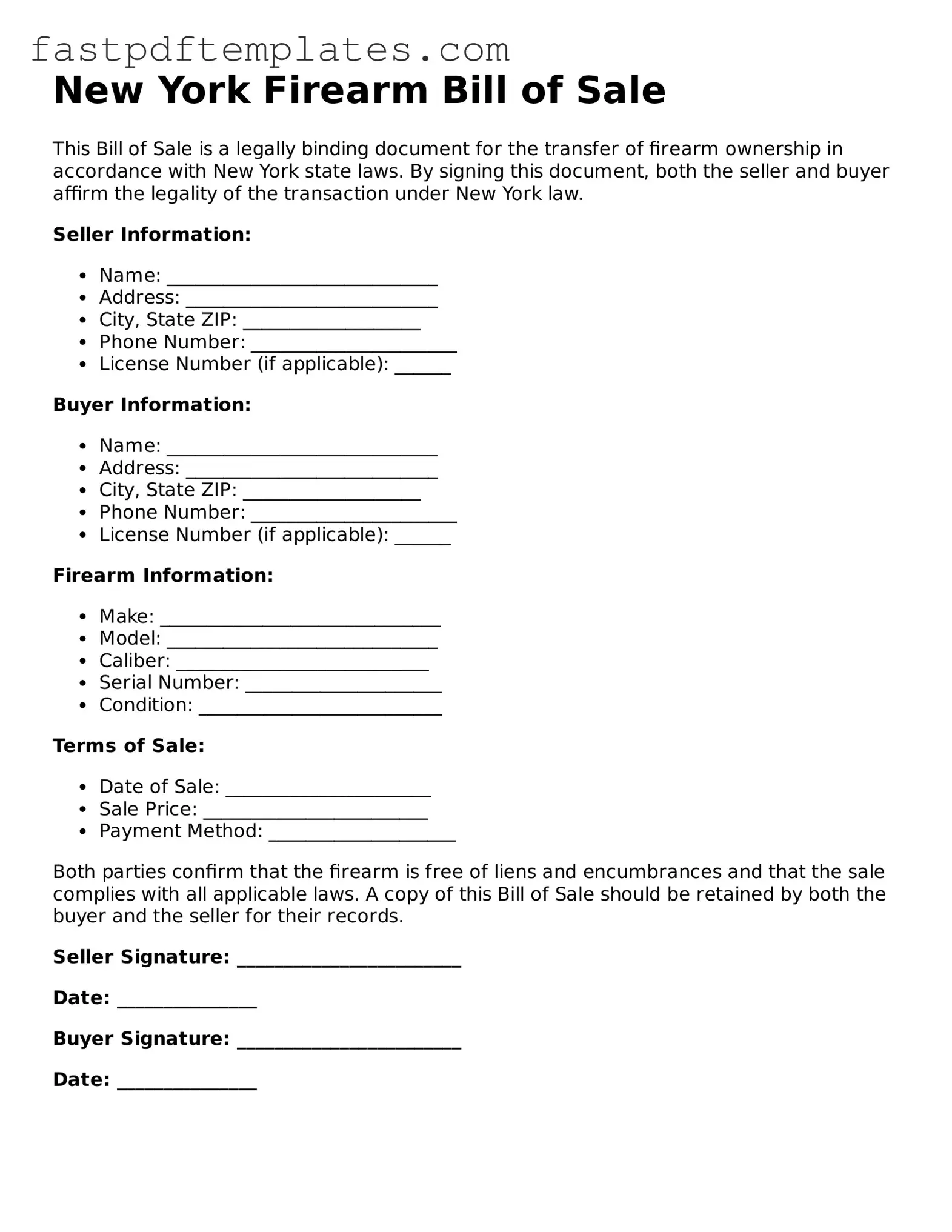The New York Firearm Bill of Sale form shares similarities with the Vehicle Bill of Sale. Both documents serve as legal proof of transfer of ownership. In the case of a vehicle, this form records the sale between the buyer and seller, detailing information such as the vehicle's make, model, and VIN. Likewise, the Firearm Bill of Sale includes essential details about the firearm, such as its make, model, and serial number, ensuring that both parties have a clear record of the transaction. This helps protect both the buyer and seller in case of disputes or questions regarding ownership.
Another document akin to the Firearm Bill of Sale is the Boat Bill of Sale. Much like the firearm transaction, a boat bill of sale outlines the transfer of ownership from one party to another. It includes pertinent information about the boat, such as its hull identification number and registration details. This document serves to confirm that the buyer has legally acquired the boat, just as the Firearm Bill of Sale affirms the buyer's ownership of the firearm. Both documents are crucial for ensuring that the transaction is documented and recognized by authorities.
The Real Estate Purchase Agreement is also similar in function to the Firearm Bill of Sale. While it deals with real property rather than personal property, both documents formalize a transfer of ownership. The Real Estate Purchase Agreement outlines terms such as the purchase price and contingencies, while the Firearm Bill of Sale specifies details about the firearm and the identities of the buyer and seller. Both documents provide a clear record of the transaction, which can be essential for future reference or legal verification.
In addition, the Equipment Bill of Sale bears resemblance to the Firearm Bill of Sale. This document is used when transferring ownership of equipment, such as machinery or tools. It includes descriptions and details about the equipment being sold, similar to how the Firearm Bill of Sale details the firearm. Both forms protect the interests of the buyer and seller by documenting the transaction and providing proof of ownership transfer.
The Personal Property Bill of Sale is yet another document that parallels the Firearm Bill of Sale. This form is utilized for a variety of personal property transactions, including furniture, electronics, or collectibles. It serves to confirm the transfer of ownership and includes details about the items being sold. Much like the Firearm Bill of Sale, this document provides legal protection for both parties involved, ensuring that the transaction is recognized and documented.
Moreover, the Business Asset Bill of Sale is similar to the Firearm Bill of Sale in that it facilitates the transfer of ownership of business-related assets. This document outlines the specifics of the assets being sold, such as equipment, inventory, or intellectual property. Both forms serve to validate the transaction and protect the rights of the buyer and seller, ensuring that ownership is clearly defined and legally recognized.
The Lease Agreement also exhibits similarities to the Firearm Bill of Sale, albeit in a different context. While a lease agreement governs the rental of property, it still involves the transfer of rights for a specified period. Both documents require clear identification of the parties involved and detailed descriptions of the item or property in question. This ensures that both parties understand their rights and responsibilities during the term of the agreement or transaction.
Another document that resembles the Firearm Bill of Sale is the Pawn Ticket. When an individual pawns an item, a pawn ticket is issued, detailing the item, its value, and the terms of the loan. While the pawn ticket does not transfer ownership in the same way a bill of sale does, it does create a record of the transaction and the item involved. Both documents serve to protect the interests of the involved parties by providing a formal acknowledgment of the transaction.
Lastly, the Gift Receipt can be compared to the Firearm Bill of Sale in that it documents the transfer of ownership without a financial transaction. While a gift receipt is typically used for personal items given freely, it still serves to confirm that the item now belongs to the recipient. In a similar vein, the Firearm Bill of Sale confirms the transfer of ownership, ensuring that both parties acknowledge the change in possession, whether or not money exchanged hands.
